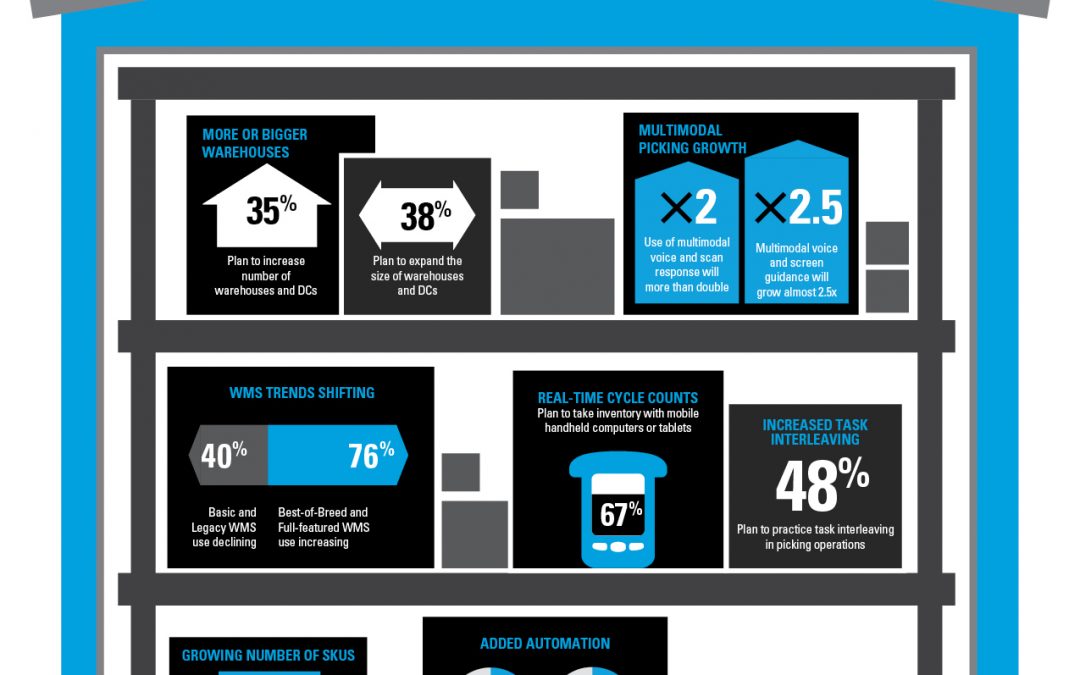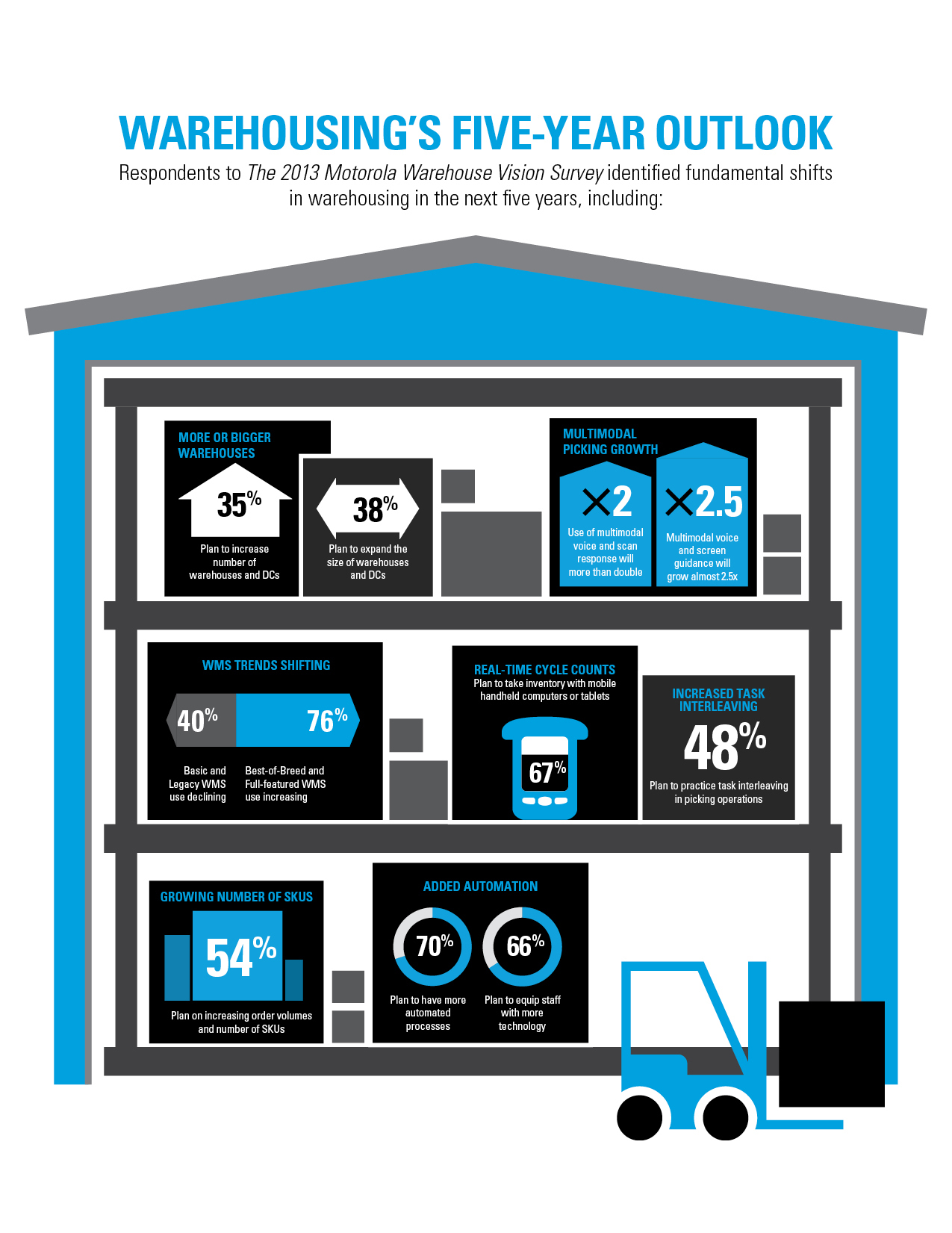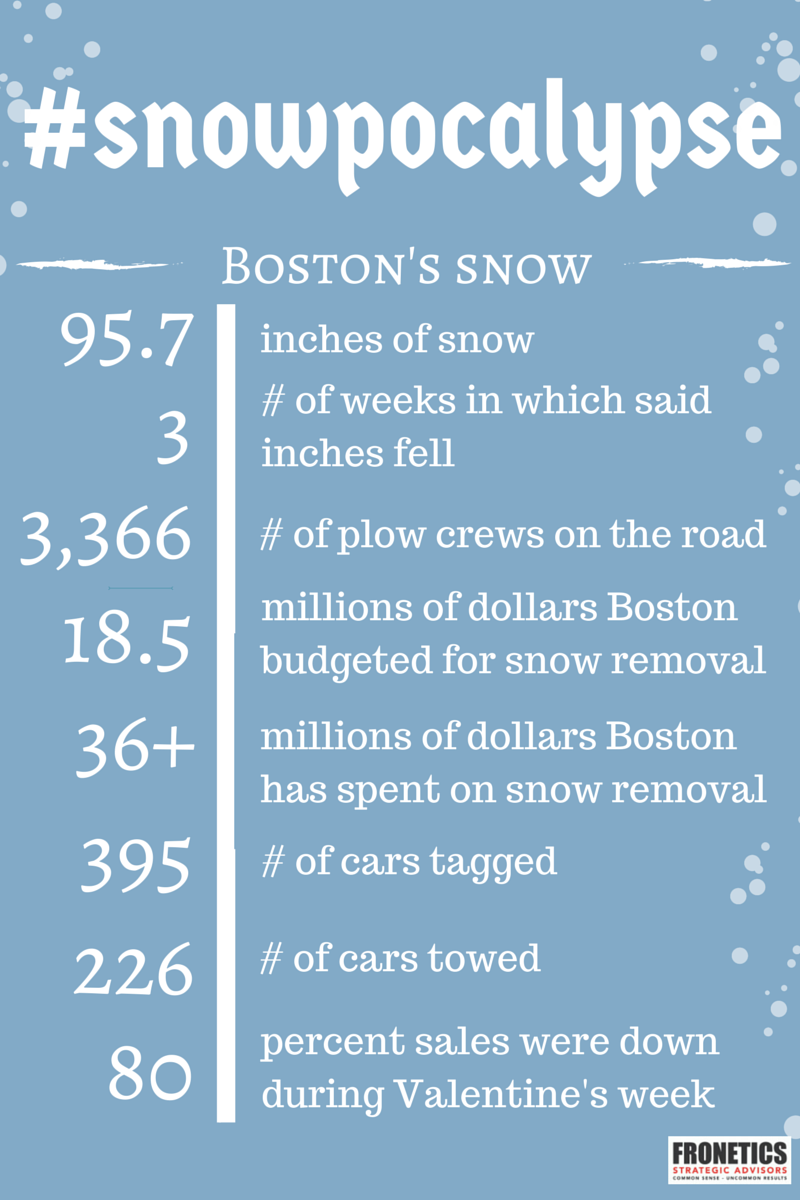
by Fronetics | Feb 19, 2015 | Blog, Strategy, Supply Chain, Warehousing & Materials Handling

Source: Motorola
Growing in concert with consumer demand, distribution centers are getting bigger. In fact, a 2013 Motorola Warehouse Vision Survey reported that a full thirty-eight percent of respondents would be increasing the size of their warehouses and distribution centers over the next five years. And while there are certainly potential benefits, there are also plenty of potential problems. With good planning, though, organizations can successfully navigate around the pitfalls of distribution center growth.
Here’s how to achieve success when growing the size of your distribution center.
Streamline operations and processes
Increasing the square footage of your distribution center requires extensive strategy pre-planning. This means taking stock of your entire logistics and distribution process and strategically thinking about how these processes can be made more efficient. Areas where many companies can increase efficiencies include: decreasing reliance on paper, cross-docking, incorporating multi-modal wireless solutions, and revamping the pick strategy.
Optimize communication across departments
Communication is essential when growing your distribution center. Communicating across departments will enable your company to be able to effectively plan for both current capacity requirements as well as capacity requirements that are forecasted in the near-, mid-, and long-term. Building a larger distribution center only to outgrow it five years later is a costly mistake. Furthermore, communication across departments will allow for the right-sizing of both equipment and labor.
Be flexible
Allowing for flexibility is a key factor of successful growth. A large distribution center that can process a limited number of SKUs is, well, limited. A distribution center that is designed to be able to process a wide variety of goods and SKUs can reduce operating costs and enable your company to be more nimble. When designing your distribution center, keep flexibility at the forefront.
Invest and utilize technology
A larger distribution center requires more automation and more technology than a smaller distribution center. Similarly, a larger distribution benefits from mobile solutions. As more specific and sophisticated technology emerges, implementing smart technologies can aid in your efforts to achieve optimization of communications and streamline your operations more efficiently.
When the square footage of your distribution center grows, it is important to remember that you are dealing with a different beast. It’s one that requires extra careful thought. Taking the time to consider potential problems and preparing a solid plan of implementation before you begin will increase your odds of successful growth.

by Fronetics | Feb 19, 2015 | Blog, Strategy, Supply Chain, Warehousing & Materials Handling

Source: Motorola
Growing in concert with consumer demand, distribution centers are getting bigger. In fact, a 2013 Motorola Warehouse Vision Survey reported that a full thirty-eight percent of respondents would be increasing the size of their warehouses and distribution centers over the next five years. And while there are certainly potential benefits, there are also plenty of potential problems. With good planning, though, organizations can successfully navigate around the pitfalls of distribution center growth.
Here’s how to achieve success when growing the size of your distribution center.
Streamline operations and processes
Increasing the square footage of your distribution center requires extensive strategy pre-planning. This means taking stock of your entire logistics and distribution process and strategically thinking about how these processes can be made more efficient. Areas where many companies can increase efficiencies include: decreasing reliance on paper, cross-docking, incorporating multi-modal wireless solutions, and revamping the pick strategy.
Optimize communication across departments
Communication is essential when growing your distribution center. Communicating across departments will enable your company to be able to effectively plan for both current capacity requirements as well as capacity requirements that are forecasted in the near-, mid-, and long-term. Building a larger distribution center only to outgrow it five years later is a costly mistake. Furthermore, communication across departments will allow for the right-sizing of both equipment and labor.
Be flexible
Allowing for flexibility is a key factor of successful growth. A large distribution center that can process a limited number of SKUs is, well, limited. A distribution center that is designed to be able to process a wide variety of goods and SKUs can reduce operating costs and enable your company to be more nimble. When designing your distribution center, keep flexibility at the forefront.
Invest and utilize technology
A larger distribution center requires more automation and more technology than a smaller distribution center. Similarly, a larger distribution benefits from mobile solutions. As more specific and sophisticated technology emerges, implementing smart technologies can aid in your efforts to achieve optimization of communications and streamline your operations more efficiently.
When the square footage of your distribution center grows, it is important to remember that you are dealing with a different beast. It’s one that requires extra careful thought. Taking the time to consider potential problems and preparing a solid plan of implementation before you begin will increase your odds of successful growth.

by Fronetics | Feb 18, 2015 | Blog, Content Marketing, Marketing, Strategy

Content curation is an essential component of a marketing strategy.
When it comes to creating and executing a successful marketing strategy, content curation is often forgotten. There are two reasons for this: 1) lack of knowledge about what content curation is; and 2) lack of knowledge about the role of content curation within a marketing strategy.
Here is what you need to know about content curation.
What is content curation?
Simply put, content curation is the act of identifying valuable content from a variety of sources and distributing via it your own platform in a strategic manner.
Heidi Cohen, President at Riverside Marketing Strategies, looked to content marketing experts so as to better understand what content curation is and how it can be used to achieve business objectives. She compiled 19 definitions. Here are three of the definitions:
Content curation is the process of identifying content created by others that will be valuable for your audience and then publishing it on your own platform. Michael Brenner of SAP and the B2B Insider blog.
Content curation is hand selecting content created by other sources and sharing them with your community. Best done when whoever is curating adds their own explanation for sharing, reaction or opinions. C.C. Chapman author of Author of Amazing Things Will Happen and co-author of Content Rules.
Content curation is the process of choosing the most relevant information to meet your readers’ needs on a specific topic like a good editor or museum curator. Content curation requires more than just the selection of information. It’s the assembling, categorizing, commenting and presenting the best content available. Heidi Cohen of Riverside Marketing Strategies.
Why content curation matters
A 2014 survey found that 76% of respondents reported that content curation positively impacted their business goals in 2013. 90% of respondents predicted that content curation will have a positive impact on their business goals in the upcoming year.
No one wants to hear about you all the time. As strange as it may sound, talking about your products, services, and your value all the time is bad for business. Here is where content curation comes in. Content curation will serve to establish your business as a thought-leader within the industry and as a trusted resource. Additionally, it will serve to increase your brand visibility. The great thing about content curation is that it enables you to achieve these business objectives without talking all about you.
Navigating the deluge of digital content available, and identifying the content that is relevant and valuable to your prospects and customers is critical.
Two things to remember:
Quality is key
There is a lot of digital clutter. Steller content curation sorts through the clutter and identifies quality content. Make sure that the content you curate is quality content and not clutter.
Be valuable and relevant
Make sure that every piece of content your curate is content that is both valuable and relevant to your prospects and customers.

by Fronetics | Feb 18, 2015 | Blog, Content Marketing, Marketing, Strategy

Content curation is an essential component of a marketing strategy.
When it comes to creating and executing a successful marketing strategy, content curation is often forgotten. There are two reasons for this: 1) lack of knowledge about what content curation is; and 2) lack of knowledge about the role of content curation within a marketing strategy.
Here is what you need to know about content curation.
What is content curation?
Simply put, content curation is the act of identifying valuable content from a variety of sources and distributing via it your own platform in a strategic manner.
Heidi Cohen, President at Riverside Marketing Strategies, looked to content marketing experts so as to better understand what content curation is and how it can be used to achieve business objectives. She compiled 19 definitions. Here are three of the definitions:
Content curation is the process of identifying content created by others that will be valuable for your audience and then publishing it on your own platform. Michael Brenner of SAP and the B2B Insider blog.
Content curation is hand selecting content created by other sources and sharing them with your community. Best done when whoever is curating adds their own explanation for sharing, reaction or opinions. C.C. Chapman author of Author of Amazing Things Will Happen and co-author of Content Rules.
Content curation is the process of choosing the most relevant information to meet your readers’ needs on a specific topic like a good editor or museum curator. Content curation requires more than just the selection of information. It’s the assembling, categorizing, commenting and presenting the best content available. Heidi Cohen of Riverside Marketing Strategies.
Why content curation matters
A 2014 survey found that 76% of respondents reported that content curation positively impacted their business goals in 2013. 90% of respondents predicted that content curation will have a positive impact on their business goals in the upcoming year.
No one wants to hear about you all the time. As strange as it may sound, talking about your products, services, and your value all the time is bad for business. Here is where content curation comes in. Content curation will serve to establish your business as a thought-leader within the industry and as a trusted resource. Additionally, it will serve to increase your brand visibility. The great thing about content curation is that it enables you to achieve these business objectives without talking all about you.
Navigating the deluge of digital content available, and identifying the content that is relevant and valuable to your prospects and customers is critical.
Two things to remember:
Quality is key
There is a lot of digital clutter. Steller content curation sorts through the clutter and identifies quality content. Make sure that the content you curate is quality content and not clutter.
Be valuable and relevant
Make sure that every piece of content your curate is content that is both valuable and relevant to your prospects and customers.
![Boston’s snow logistics [Infographic]](https://www.fronetics.com/wp-content/uploads/2024/10/Boston-snow-logistics-800x675.png)
by Fronetics | Feb 17, 2015 | Blog, Current Events, Logistics, Strategy
The logistics of Boston’s snow #snowpocalypse
For the past three weeks we have been pretty much like this: shovel, snow blow, tackle commutes, juggle school cancellations, repeat.
Charlotte Wilder expressed the sentiments of many when she penned A Breakup Letter to Snow From the City of Boston. 95.7 inches of snow within 3 weeks is a lot of snow. The sheer amount of snow has forced the city’s public transportation to cancel operations. Schools have been cancelled, several for two weeks or more. Cars have been buried. Businesses have been forced to close. Businesses that have remained opened have realized dismal sales. Boston has opened snow farms and has purchased melting trucks. National Guard troops have been called in to help remove snow. #snowpocalypse 2015.

The snow has complicated the logistics of life. As we, individuals and businesses, complain about the economic, physical, and mental challenges associated with the snow it is important to put things into perspective. NPR’s Barbara Howard’s Blizzard of Perspective does just that.




![Boston’s snow logistics [Infographic]](https://www.fronetics.com/wp-content/uploads/2024/10/Boston-snow-logistics-800x675.png)
